In the early 1990s, a group of scientists had a dream: a new type of telescope that would push astronomy, astrophysics, and imaging technology further than ever before. It would be a device that could see giant swaths of the sky and help unravel the mystery of dark matter. 30 years later, that dream is a reality.
What started as a rough sketch took form over the next decade and in 2003, the LSST Corporation was formed as a non-profit that would support the project. In 2007, the LSST received critical financial backing from Charles Simonyi and Bill Gates in the form of $20 million and $10 million, respectively, to be used to construct the telescope’s mirror array.
It was at this point that the dream started to feel “real” to those involved.
A Decade-Long Journey
In 2010, the project was given federal funding from the National Science Foundation (NSF) and the Department of Energy (DOE), and construction of the telescope was able to begin under the name Large Synoptic Survey Telescope (LSST).
![]()
In 2015, ground was broken in Cerro Pachón, Chile, where the huge telescope housing for the massive camera would be built. Over the next few years, individual parts of the entire observatory system, including the camera, would be constructed in different parts of the world. The construction of the camera began in earnest in California. The steel telescope mount structure came together in Spain. The secondary mirror was assembled in New York.
In 2018, the telescope mount and both mirrors came together in Chile. In December 2019, the United States Congress confirmed a new name for the telescope: the Vera C. Rubin Observatory, named after the pioneering American astronomer who made significant contributions to astronomy and astrophysics.
![]()
“Rubin Observatory was the first major, publicly-funded astronomy facility in the United States to be named after a woman,” the observatory’s team says.
While the observatory got a new name, the acronym LSST stuck and the project would continue with it under the name Legacy Survey of Space and Time.
Even though major pieces of the telescope were being assembled together as early as 2018, it would be nearly six more years before what is arguably the most important aspect of the system — the 3,200-megapixel LSST camera — was completed. That finally happened on April 3, 2024.
Huge Doesn’t Even Begin to Describe the LSST Camera
I and my colleagues Chris Niccolls and Jordan Drake were given the incredible opportunity to visit the Stanford Linear Accelerator Center (SLAC), where the now-completed LSST camera has been for the last decade. Before it is packed up and carefully shipped to Chile, the three of us were able to spend a few hours with it alongside two of the engineers who were part of its construction.
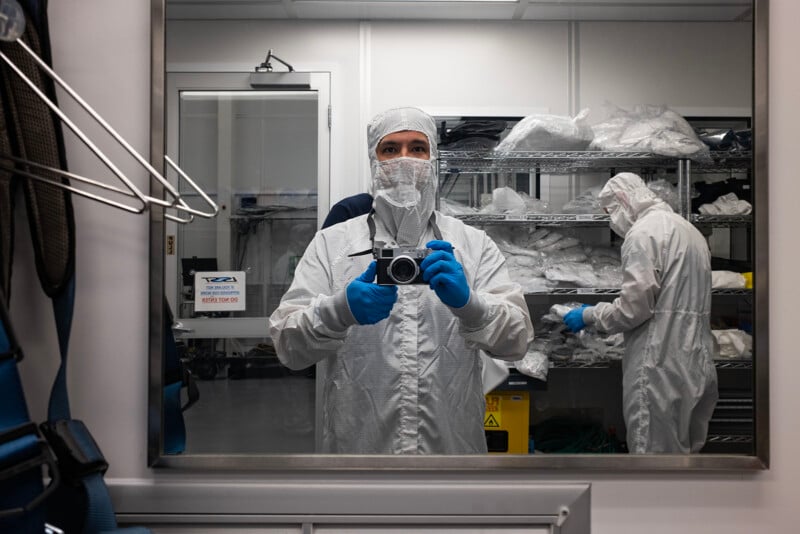
This is, in short, the biggest digital camera ever constructed. Before it is even installed into the observatory, which is massive, the camera weighs a whopping 3,000 kilograms. That is equivalent to 1,500 Nikon 58mm f/0.95 Noct lenses (Chris’s favorite weight conversion).
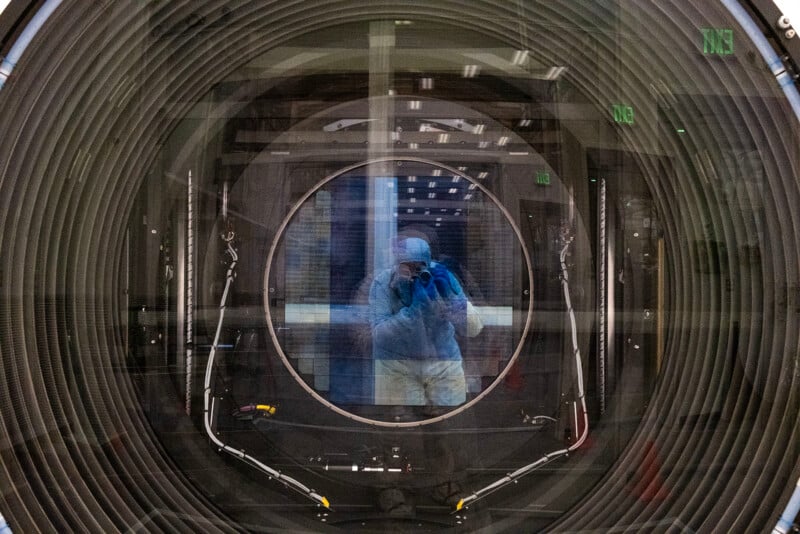
It’s so huge because of the massive resolution it is capable of capturing. The imager is made up of 21 rafts each of which holds nine CCD sensors that make up the array. To give context, one single sensor will photograph enough of the sky to contain tens of thousands of galaxies and stars at one time — and there are 189 present.
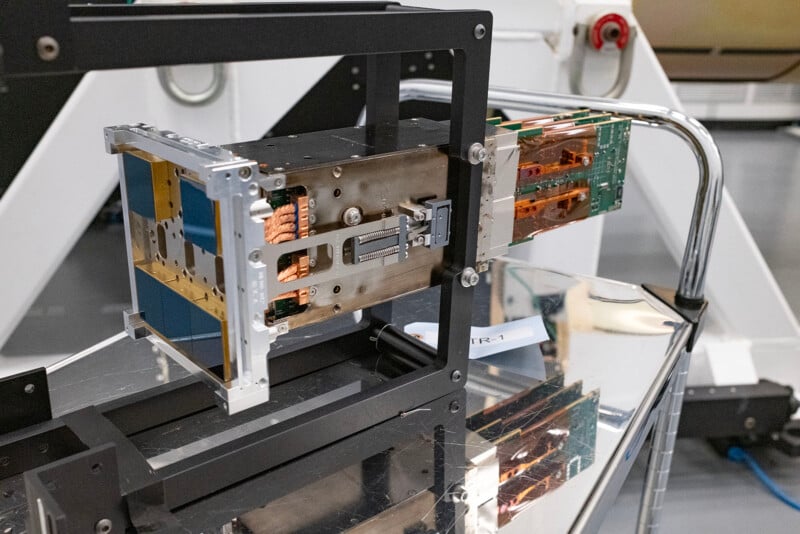
These sensors may only have about 16 megapixels of resolution, but the pixels are much larger than those found on consumer cameras. Just one of the LSST’s sensor units dwarfs the one found in the Hasselblad X2D 100C, one of the highest-resolution medium-format digital cameras currently available.
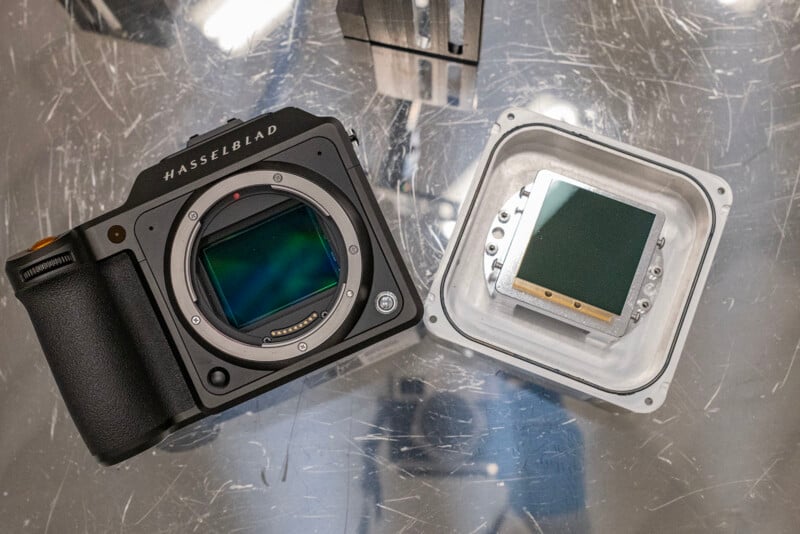
The CCD chips on the sensor are designed to be so sensitive that ambient light recording light is not possible as it is too saturated. While constructing the LSST, a large number of sensors were thrown out as they did not meet the necessary specifications. For example, the sensor had to be within four microns of perfect flatness in order to pass. As a reference, the human hair is on average 70 microns thick.
“One of the main technical challenges with assembling this camera was installing the sensor assemblies. I created a slew of concepts but didn’t feel great about any of them. So we eventually had a brainstorming session and that led to an idea I hadn’t thought of,” Travis Lange, LSST Camera deputy project manager and camera integration manager says.
“The rest of the process involved creating the detailed design with a lot of tolerance analysis to ensure the mechanism used to install the sensors had the necessary accuracy.”
![]()
![]()
That flatness is achieved using an array of ceramic carbon reinforced mounts along with three balls of different diameters to calibrate, combined with the option to shim the sensors themselves. Remarkably, the machining work was so precise that getting almost perfect flatness was easier than anticipated — one of the few times that can be said of the camera’s construction.
Each sensor captures a 4,000 by 4,000 pixel area, with each pixel within that being 10 microns in size. The diameter of the sensor area is 640mm across (about 25.2 inches) the roughly circular array. Altogether, the LSST is capable of capturing 3,200-megapixel photos. The Subaru Telescope located at the Mauna Kea Observatory in Hawaii is the closest previously existing camera in terms of size as it is only slightly smaller physically but has a sensor array that is roughly half the size of the LSST.
To better put what the LSST can do into perspective, the animation below shows how it compares to some other well-known systems (courtesy of Margaux Lopez):
The sensor array operates at a temperature of -100 degrees Celsius (thanks to a massive refrigeration unit that can both heat and cool to maintain equilibrium) and, to avoid condensation, does so in a complete vacuum. Maintaining that vacuum is itself a challenge, and last year a leak was discovered that took the team months to resolve.
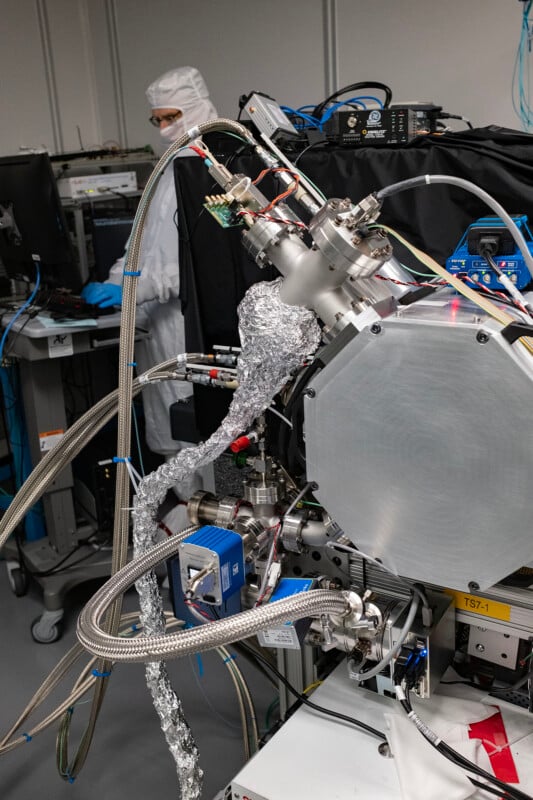
The sensor is only half of the equation, of course. The lens is no less impressive, sporting a 3.5-degree diameter field of view, which translates to about a 7.5 times wider field of view than the full moon in the night sky. It has an equivalent aperture of f/1.23 and the 1.55 meter diameter of the front element makes it the biggest in the world.
![]()
“I expected the process of installing the large lens assembly to be very difficult because it has six separate feet which need to be attached simultaneously. We made plans for three people to each manage two feet, and I thought managing that would be really difficult. But my paranoia was thankfully unfounded,” Lange says and points to the photo below showing the process of installation.
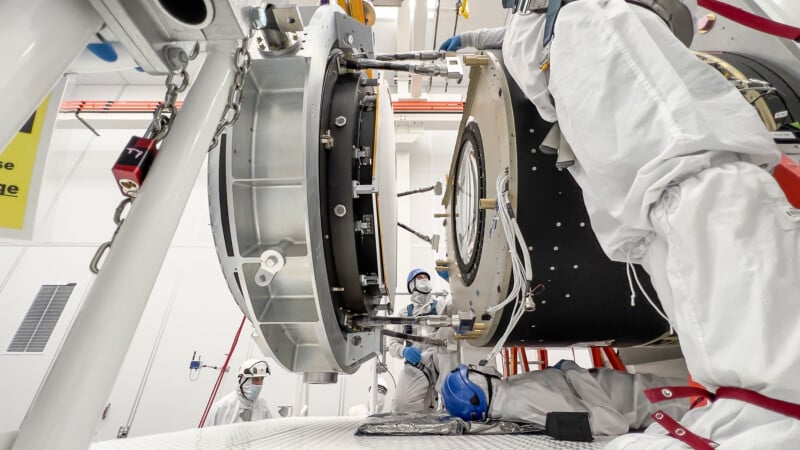
Between the lens array and the sensor is a massive mechanical shutter that can fire as fast as 0.9 seconds when the sensor is fully revealed. It can do a sliver shutter for faster speeds (where the two curtains are close together and move across the plane of the sensor in unison) but practically speaking, a long exposure of 15 to 30 seconds per shot is considered the “nominal range” that will actually be used by scientists.
The resolution of this sensor is extraordinary. If it were aimed in the manner of a traditional camera, it could resolve a golf ball 15 miles away while also covering a swath of the sky seven times wider than the full moon.
As huge as the LSST is, it is dwarfed by the size of the full observatory that was custom-made for this digital camera system. As you can imagine, this project took a gargantuan effort from a huge number of people.

“There have been many engineering challenges and many setbacks but I think one of the most challenging things for me personally has been how long the project has gone on. I kind of expected to be onto something new by now, but I’m still working on this same thing,” Margaux Lopez, a mechanical engineer on the LSST construction team, says.
“Since I started working on this project in 2015 (my first engineering job after graduating from college), I’ve always been planning to take a year or two off to go frolic in the mountains after this project is over and I kind of thought I would be doing that by now but turns out I’m still here and I sometimes (often?) wonder why. But I think it’s in human nature to pursue discovery. The main driver of this entire project is curiosity,” she continues.
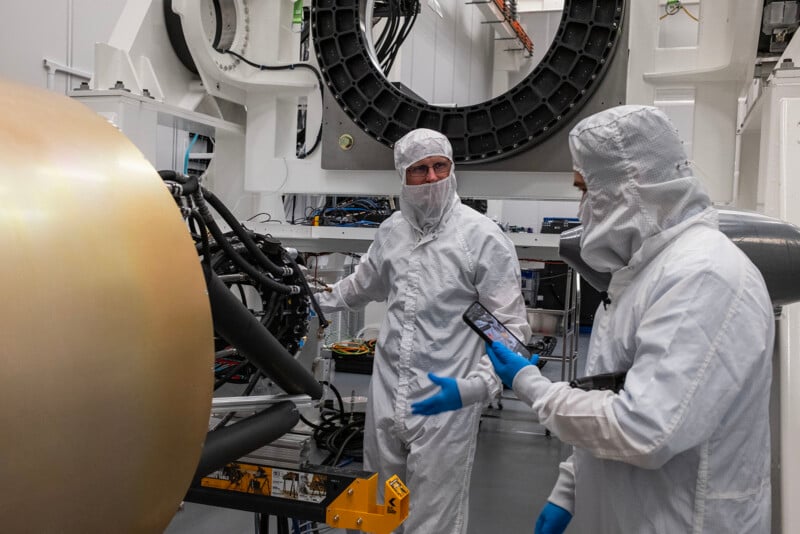
“Exploring the unknown, whether it’s a remote mountaintop or a far-away galaxy, is a fundamental human desire. Working on a scientific instrument that will help us discover more about our past and ourselves feels meaningful and thus worth the decade of my life that I’ve dedicated to it.”
Homeward Bound
Before it can do anything, the LSST has to get from Stanford, California to the top of a mountain in Chile. The camera is extremely fragile, which means unique shipping arrangements are necessary. The LSST will be inserted into a specially designed shipping container that is outfitted with shock absorbers and sealed against dramatic changes in temperature. After that, it will be loaded onto a specially chartered airplane before being carefully, and slowly, driven up the mountain.
“There are plenty of ways in which we could have problems before the camera gets installed on the telescope, from damage during shipping to some inaccessible component suffering early lifetime failure. We’ve run into plenty of issues along the way, and I’m sure we’ll come across others, but we have an amazing group of dedicated, intelligent people who have worked together to resolve many issues during construction,” Lange says.
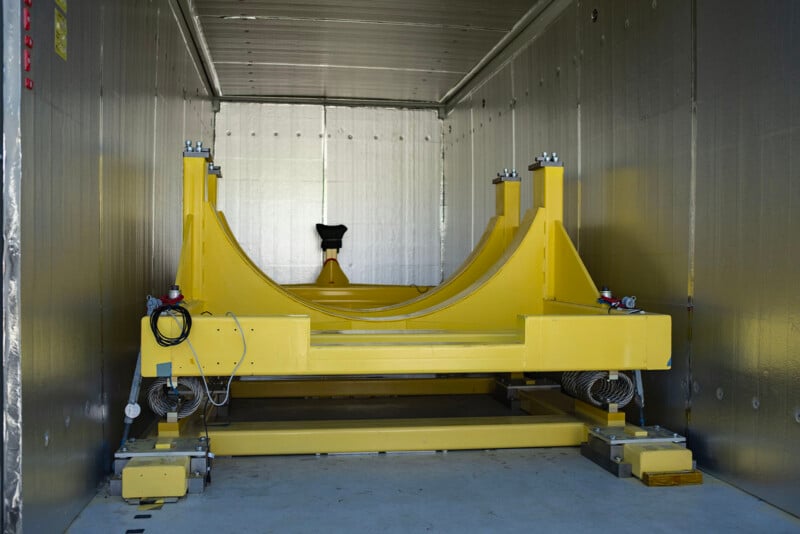
“I am most proud of the shipping plan which I have put a lot of work into over the last five years,” Lopez adds.
“I’m confident we’ll be able to resolve any future issues that we come across. Risks can’t be completely eliminated, but we can spend time and effort on minimizing them as much as possible; hence Margaux’s five years of continuously developing the shipping plan!” Lange continues.
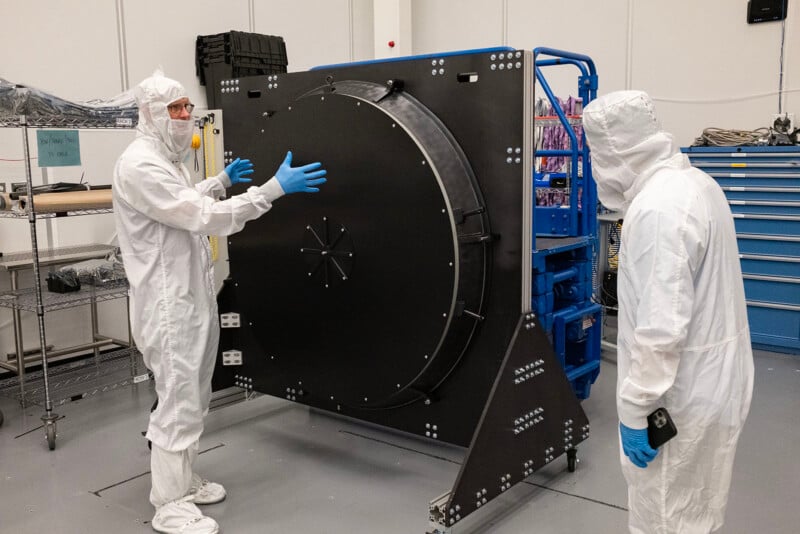
“I’m less concerned about the installation itself and a little more concerned about the operation of the camera after it’s installed. We have never operated the camera at altitude or in the observatory conditions with the telescope utilities and we’ve done a very thorough job of testing as many of those things as we can ahead of time (both with the commissioning camera that we sent to Chile early and by recreating summit conditions in the lab at SLAC) but there are always going to be things that are unexpected,” Lopez explains.
“That being said, we’ve had a number of things pop up that we just didn’t expect in the last year and we have an incredibly capable team in place to react to anything that goes wrong. I don’t think it’s fair to say that things won’t go wrong but I do think it’s fair to say that we will be able to fix or mitigate them quickly.”
The Mission of the LSST
The LSST will be used to explore the sky en masse, studying celestial bodies and their relationship with each other and how they are distributed. It will also attempt to tackle the mysteries of dark matter and how it is distributed throughout the universe. Expect the detection of asteroids, their location, and their movement over time.
Over the course of the 10-year survey, the LSST will spend time capturing each part of the southern sky more than 800 times which will allow scientists and astronomers to create a fully dynamic movie of the universe. Essentially, the LSST will be capturing a 10-year timelapse and all that data will be available to the scientific community to further the knowledge of the universe.
Lopez says that the best way she has found to describe the goal of the LSST to the average person is that it is just trying to gather as much data as possible all at once.
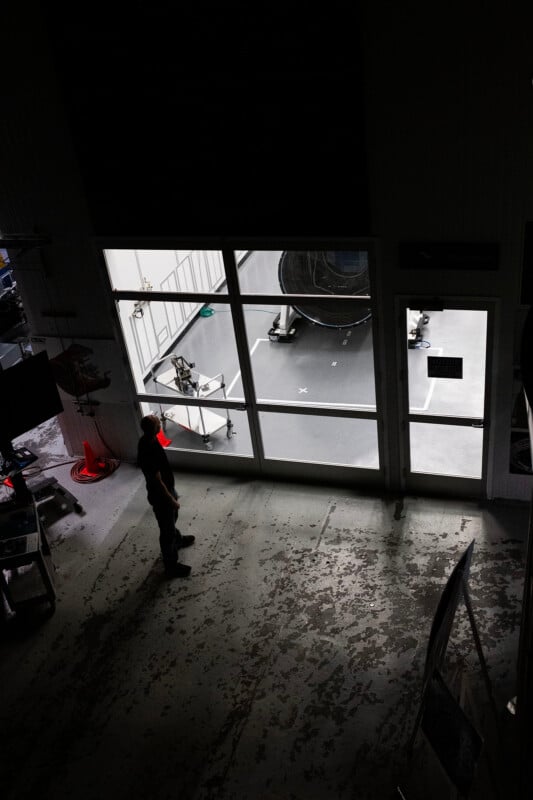
“I have found that this tends to resonate: finding anything interesting in space is similar to finding a needle in a haystack, so our goal with this project is not necessarily to immediately predict exactly where the needles are or what kind of needles we might find, but instead to collect as many haystacks as we can to increase the odds of finding something new. The designs of this telescope and this camera are focused on gathering an incredibly large amount of data, and we’re bound to find some interesting needles in a cosmic-sized haystack,” she says.
“I’m excited about what we’re going to find in our cosmic backyard. The little cartoon models of our solar system do a disservice to how unbelievably vast it is, and how little we actually know about the millions of objects in it. Will one of the objects in the Kuiper Belt or the Oort Cloud get reclassified as a planet? Maybe!” Lange tells us.
“It would be nice to discover some aliens because then hopefully people will stop asking me whether we’re going to find aliens with this instrument or not,” Lopez says, laughing.
“But more realistically, I think that there are likely phenomena in space that humankind has never witnessed because we’ve never been able to take pictures at this depth and at this time scale before, and finding something that we’ve just never seen before would be pretty freaking cool.”
Image credits: Unless otherwise noted, photos by Jaron Schneider for PetaPixel
